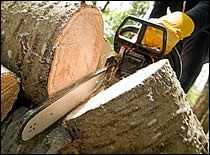Preventing Chain Saw Injuries During Tree Removal After a Disaster

Stay Safe
- Wear proper protective clothing and glasses.
- Choose the proper size of chain saw to match the job.
- Operate, adjust, and maintain the saw according to manufacturer’s instructions.
- Take extra care in cutting “spring poles” trees or branches that have been bent, twisted, hung up on, or caught under another object during a high wind.
- Be sure that bystanders are at a safe distance from cutting activities.
Check around the tree or pole for hazards, such as nails, power lines, or cables, before cutting.
Be aware of the risk of chain saw injury during tree removal

Each year, approximately 36,000 people are treated in hospital emergency departments for injuries from using chain saws. The potential risk of injury increases after hurricanes and other natural disasters, when chain saws are widely used to remove fallen or partially fallen trees and tree branches.
Safeguards against injury while using a chain saw
- Operate, adjust, and maintain the saw according to manufacturer’s instructions provided in the manual for the chain saw.
- Properly sharpen chain saw teeth and properly lubricate the blade with bar and chain oil. Additionally, periodically check and adjust the blade to keep the correct tension on the chain to keep it from coming off the blade, and ensure good cutting action.
- Choose the proper size of chain saw to match the job, and include safety features such as a chain brake, front and rear hand guards, stop switch, chain catcher and a spark arrester.
- Wear the appropriate protective equipment, including hard hat, safety glasses, hearing protection, heavy work gloves, cut-resistant legwear (chain saw chaps) that extend from the waist to the top of the foot, and boots which cover the ankle.
- Check around the area where you are cutting for possible hazards like nails or cables, both inside the wood itself, or in debris laying around the tree or limb.
- Avoid contact with power lines until the lines are verified as being de-energized.
- Always cut at waist level or below to ensure that you maintain secure control over the chain saw.
- Clear the area of cut limbs and wood as you work to allow for safer use of the saw, and to provide an escape path in case of sudden unanticipated movement by trees and limbs.
- Bystanders or coworkers should remain at least 2 tree lengths (at least 150 feet) away from anyone felling a tree and at least 30 feet from anyone operating a chain saw to remove limbs or a fallen tree
- If injury occurs, apply direct pressure over site(s) of heavy bleeding; this may save lives.
Beware of injury from the release of bent trees or branches
Take extra care in cutting “spring poles” trees or branches that have gotten bent, twisted, hung up on, or caught under another object during a high wind. If the tree or the branch is suddenly released, it may strike the person cutting it, or a bystander, with enough force to cause serious injury or death. Even a seemingly small tree or branch (2 inches in diameter, for example) may pose a hazard when it is released from tension.
To avoid injury:
- Identify the maximum point of tension on the spring pole
- Slowly shave the underside of the tree rather than cut through to allow the tree or branch to release tension slowly
How the public can help
- It is best to have a chain saw operator who has training and experience in safe chain saw use and cutting techniques to fell and remove limbs from trees.
- Be sure that bystanders are at a safe distance from cutting activities, the chain saw operator uses personal protective equipment, and workers follow safety guidelines.
For more information, see: PSA: Preventing Chain Saw Injuries After a Disaster
- Page last reviewed: October 17, 2017
- Page last updated: October 17, 2017
- Content source:


 ShareCompartir
ShareCompartir

